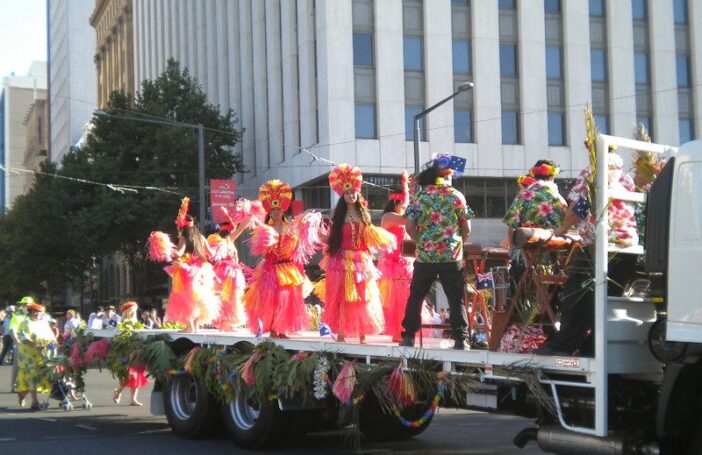Last year, we tried to identify as accurately as possible the number of people with a Pacific Island heritage living in Australia counted in the 2006, 2011 and 2016 censuses. Now 2021 census data is available, and we can update our results.
Those interested in the methodology can check out that earlier blog. In brief, we count those with Pacific heritage, not those born in the Pacific (for some countries, the two are very different); we look at the independent Pacific Island countries (excluding both Australia and New Zealand) as well as Timor-Leste, which is increasingly grouped with the Pacific in Australian policy initiatives; and we include, and adjust for under-reporting of, Indo-Fijians.
By our count, there were 337,000 people of Pacific heritage at the time of the 2021 census. That’s about twice as many as in 2006. The Pasifika share in Australia’s total population, now 1.3%, is growing because the number is growing more than twice as fast as the total Australian population. The average growth rate for the entire period is 4.3%, and it has picked up in the last ten years to 4.5%.

The next graph drills down to different ethnic groups or countries of heritage. The biggest is the number with a Fijian heritage, whether indigenous or Indo-Fijian. But quickly catching up to them is the number of Samoans, who in the 2021 census numbered almost 100,000.
The number on the top of the dark brown bars is the ratio of the 2021 to the 2006 population. For the Pacific as a whole that ratio is 1.9 – so there were almost twice as many people of Pacific heritage in Australia in 2021 as in 2006. Samoa’s ratio of 2.5 is not the highest of all countries, but it is for those with a significant diaspora, say above 5,000. Tonga and Cook Islands are also top-five countries and have a ratio of 2.4. Fiji has a lower ratio of 1.6. This may reflect problems in estimating the Indo-Fijian population, or it may just reflect a high base to begin with, that is, a mature migration profile. The two biggest countries in the Pacific, PNG and Timor-Leste, both have a ratio of 1.8, indicating below-average growth.
In 2006, there were more Papua New Guineans in Australian than Cook Islanders. That is no longer the case. Given that PNG has a population of some 9 million and Cook Islands of less than 20,000, this is remarkable.

We’ve written before about the influence of New Zealand on patterns of Pacific migration to Australia. Citizens of Samoa, Tonga and Cook Islands have long had full or significant access to New Zealand. Many migrate to New Zealand, obtain New Zealand citizenship, and then migrate to Australia. Two-thirds of the increase in the Pasifika population in Australia between 2006 and 2021 is from these three nations.
The Pacific population in Australia is growing faster than that of New Zealand. The ratio of Pacific nationals in Australia to New Zealand has increased between 2006 and the most recent census (2018 or 2021) for every nationality except for i-Kiribati. For example, the ratio of Samoans in Australia to Samoans in New Zealand increased from 30% in 2006 to 45% in 2018, and Tongans from 36% to 53%.
However, Australia is still a long way behind when it comes to Pacific representation. New Zealand’s Pasifika share (including Indo-Fijians but not making any adjustment for undercounting) increased from 6.9% in 2006 to 8.7% in 2018. The comparable figures for Australia (without the Indo-Fijian adjustment) are 0.5% and 1.0% (2006 and 2021).
There is a strong correlation between the share of the various Pacific nationalities in Australia and in New Zealand. PNG is the only Pacific country of heritage with a higher share of the Australian population than of the New Zealand one.
Samoans, Tongans and Cook Island Maori are the fifth, sixth and seventh most populous ethnic groups in New Zealand. For Australia, Fijians (including both indigenous and Indo-Fijians) are 26th and Samoans are 30th. Tongans are next on 57th. Papua New Guineans are just 80th, right behind Latvians (Latvia has a population of 1.8 million).

The Pacific Engagement Visa is the first attempt for Australia to have a Pacific migration policy – as against a temporary labour mobility scheme – independent of New Zealand’s. It will be interesting to track its impact in future censuses.
Note: The data is available in this Excel spreadsheet.





Is it possible to provide a breakdown into people who are fully of Pacific Islander heritage and people who are just partially of Pacific Islander ancestry, mixed with other ethnic groups?
Hi Peter. Yes, that’s possible. In the Census, each person can claim up to two ancestries. So it is possible to identify the number of people who claim only Pacific ancestries, as well as those who claim both Pacific and other ancestries.